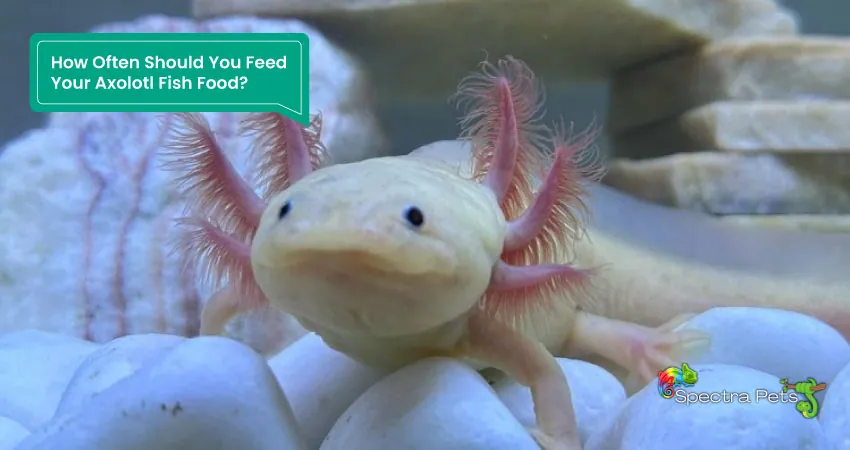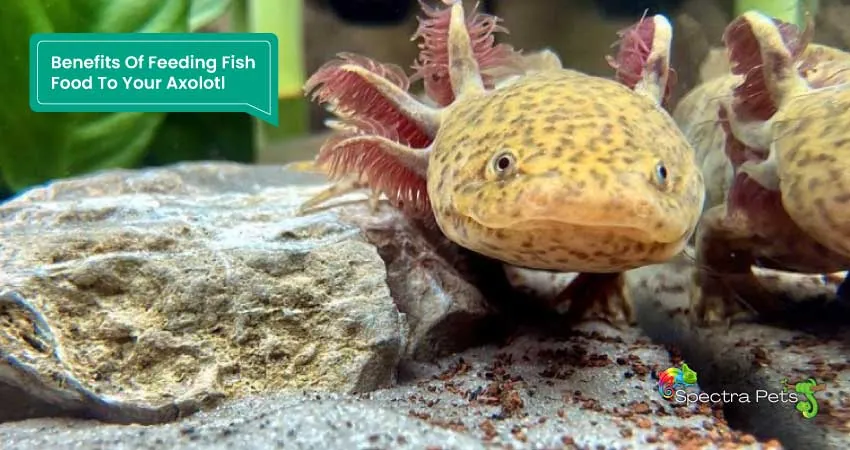Fish food is not a dietary staple for axolotls, which are carnivorous. In the wild, axolotls primarily eat worms, insects, and small fish. However, in captivity, they will accept a variety of foods, including pellets designed specifically for them as well as live food such as earthworms or brine shrimp.
Now, the question arrives, can axolotls eat fish food? Well, though fish food may not be essential to an axolotl’s diet, it can be offered as a treat or occasional snack. But, you should provide meat-based fish food or pellets to your axolotls as they are carnivorous. That also means that they won’t eat plant-based foods.
Now, let’s have a look at what type of fish food you can offer your axolotls.
7 Popular Fish Food You Can Offer To Your Axolotl

There are a variety of meat-based fish foods available that you can offer your axolotl as a treat or snack. Here are some of them you can try:
- Freeze-dried bloodworms: These are a favorite among many axolotl owners and are easy to find in pet stores. Bloodworms offer a handful of vitamins and proteins that are beneficial to axolotls.
- Pellets: There are many meat-based pallets that are a good source of nutrition for fish and axolotl. When buying pellets, make sure to check the ingredients list. As long as the fish food you offer your axolotl is meat-based and nutritious, they will be fine eating it as a treat or snack. Avoid offering plant-based pellets.
- Live earthworms: Axolotls enjoy live earthworms as a treat. These insects are excellent food sources for young axolotls (from 3 months of age). You can find these at bait shops or dig them up yourself in your backyard. Just make sure they’re clean and free of pesticides before feeding them to your axolotl.
- Frozen earthworms: Though many axolotls owners claim that their axies don’t love frozen earthworms, you can supply these to your axolotls as an occasional treat if they don’t mind having frozen earthworms. As frozen earthworms contain a high level of iron and protein, they can be a good nutritional supplement for your axolotl.
- Brine shrimp: Brine shrimp is also an excellent food source for your axolotl. They are small, easy to feed, and easy to find in pet stores. These foods are not only tasty but also offer a good source of protein, lipids, and fatty acids. However, don’t make brine shrimp the only food source for your axolotl as they need a variety of foods to stay healthy.
- Daphnia: Daphnia is another great source of meat-based fish food for your axolotl. They are similar to brine shrimp and offer a good source of nutrition, including rich proteins, fat and minerals. Daphnia is also easy to find in pet stores.
- Nightcrawlers: Nightcrawlers are live earthworms that you can offer as a treat to your axolotl. These larger worms provide a good source of protein and fat. You can find them at bait shops and need to cut them into smaller pieces before feeding to your axolotl.
Now you know what type of fish food you can offer your axolotl. But, there are still some things you need to keep in mind before feeding fish food to your axie. Let’s have a look at them.
Things To Consider Before Feeding Fish Food To Your Axolotl

Before feeding fish food or any other food to your axolotl, there are a couple of things you need to take into consideration:
The size of the food:
Make sure the food you’re offering is small enough for your axolotl to eat smoothly. If the food is too large, your axolotl may have trouble eating it and may even choke on it.
The frequency of feeding:
Don’t overfeed your axolotl as this can lead to health problems. Feed them fish food or any other food only as a treat or occasional snack.
The nutritional value of the food:
As we mentioned earlier, axolotls are carnivorous, so they need a diet that’s high in protein and low in carbohydrates. That means you should avoid feeding them plant-based foods as they won’t get the nutrients they need from them.
Now that you know what to consider before feeding fish food or any other food to your axolotl, let’s have a look at how often you should feed them.
How Often Should You Feed Your Axolotl Fish Food?

You should only offer fish food or any other food to your axolotl as a treat or occasional snack. That means you shouldn’t make it a part of their regular diet. How often you feed them fish food or any other food depends on a few factors such as their age, size, and activity level.
For example, if you have a juvenile axolotl that’s between 3–6 months old, you can feed them once or twice a week. If you have an adult axolotl, you can feed them once every two weeks.
Now that you know how often to feed your axolotl fish food, let’s have a look at the benefits of offering fish food as a treat or snack.
Benefits Of Feeding Fish Food To Your Axolotl

There are a few benefits of feeding fish food or any other food to your axolotl:
It’s a good source of protein: As we mentioned earlier, axolotls are carnivorous, so they need a diet that’s high in protein. Meat-based fish food is an excellent source of protein and offering it to your axolotl can help them get the protein they need.
It can help with their growth: Fish food is also a good source of vitamins and minerals that can help with your axolotl’s growth.
Convenient: Fish food is readily available in pet stores and is easy to store, making it a convenient food source for axolotl owners. It eliminates the need to hunt for live prey or worry about food storage and preservation.
It’s a good way to bond with your axolotl: Feeding time is a great opportunity to bond with your axolotl. Not only will they appreciate the food, but they’ll also enjoy the attention you’re giving them.
Now that you know the benefits of feeding fish food or any other food to your axolotl, let’s have a look at the downside of doing so.
Drawbacks of Feeding fish food
Fish foods are specially made for pet fishes, and you can’t provide all types of fish foods to your lovely axolotl. Moreover, some types of fish food aren’t recommended for them, and some types of fish foods aren’t liked by them. In order to ensure your axolotls make the most of the fish food, you must provide the right types of fish food.
I hope this article has helped you get some insight regarding feeding fish foods to your adorable axolotl. Good luck.
